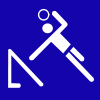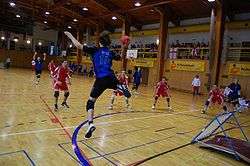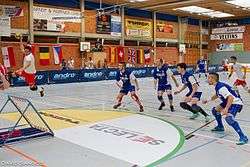Tchoukball
|
A tchoukball match in progress. | |
| Highest governing body | Fédération Internationale de Tchoukball (FITB) |
|---|---|
| First played | 1970 |
| Characteristics | |
| Contact | No |
| Team members | 7 on Court , 5 Reserve (beach: 5) |
| Mixed gender | Not in international championships, but very common in some national championships |
| Type | Ball sport, team sport |
| Equipment | Tchoukball, frame |
| Presence | |
| Country or region | Worldwide |
| Olympic | No (demonstrated at the 2009 World Games) |


Tchoukball /ˈtʃuːkbɔːl/ is an indoor team sport developed in the 1970s by Swiss biologist Hermann Brandt.
The sport is usually played on an indoor court measuring 27 metres by 16 metres. At each end there is a 'frame' (a device similar to a trampoline off which the ball bounces) which measures one square metre and a semicircular D-shaped forbidden zone measuring three metres in radius. Each team can score on both ends on the field, and comprises twelve players, of which seven may be on the court at any one time. In order to score a point, the ball must be thrown by an attacking player, hit the frame and bounce outside the 'D' without being caught by the defending team. Physical contact is prohibited, and defenders may not attempt to intercept the attacking team's passes. Players may take three steps with the ball, hold the ball for a maximum of three seconds, and teams may not pass the ball more than three times before shooting at the frame.
Tchoukball has become an international sport, played in Brazil, Canada, China, the Czech Republic, Great Britain, China, India, Italy, Japan, Macau, Philippines, Singapore, Switzerland, Taiwan, and the United States. It is governed by the Féderation Internationale de Tchoukball (FITB, founded in 1971). Taiwan hosted the 2004 World Championships and won both the women's and junior championships, with the Swiss men winning the men's championship. The 2006 European Championships were held in Switzerland, with Great Britain taking both the Men's and Under-18's titles, while the hosts won the Women's event.
History
Tchoukball was created in Switzerland by Hermann Brandt, who was concerned by the numerous serious injuries among athletes resulting from sports prone to aggression and physical contact. He believed that sports should not only form champions, but also contribute to the creation of a better and more humane society.[1] He designed tchoukball to contain elements of handball (it is played with hands, and the balls used are similar), volleyball (as the defending team must prevent the ball from falling) and squash (since there is a bounce).
Basic Rules
Court
- The court size that is generally used is 27 m × 17 m. However, there are variations to this such as in beach tchoukball where a court size of 21 m × 12 m is used.
- One rebound frame is placed at each end of the field of play
- In front of each frame, a D shaped semi-circle measuring 3 m in radius must be drawn; it defines the limits of the 'forbidden zone'
- The lines of the zones are considered part of the zone itself, e.g. the line marking the semicircle forbidden zone is considered part of the forbidden zone, while the line around the entire court is considered a part of the court
Ball
Depending on the category of players (Men/Women/M18/M15/M12), different sizes of balls are used ranging from a circumference of 54 cm to 60 cm and weighs between 325 grams to 475 grams.
Scoring
Two teams of 7 players each (men or women) compete to score points with the team with the most points at the end winning the game. When a team gains a point, control of the ball is transferred to the other team.
- In tchoukball either team can score at either end of the court.
- A point is scored when the ball rebounds after hitting either of the 2 frames and touches the ground outside the forbidden zone, any part of the defending player's body below the knees, or touches the defending player while he is still in the forbidden zone.
- A point is given to the non-attacking team when the attacking team shoots and misses the frame, or the ball rebounds outside the playing area (either out of the court or in the forbidden zone).
- If a shot is caught by the defending team, the defending team can proceed to attack immediately.

Positions
Each team comprises the following positions:
- 2 Right Wings
- 2 Left Wings
- 2 Forward Pivots (FP)
- 1 Centre Pivot (CP)
Each side of the court comprises a left shooter (Left Wing), right shooter (Right Wing) and an inner (FP), while the centre pivot usually stays near the middle of the court. The shooters are generally in charge of shooting although in some cases the inner can also take the shot. The inners are in charge of coordinating the first line defence while the centre pivot takes charge of the second line defence. However other formations include not using a centre pivot, the team would bypass the centre and throw full length court passes directly to the shooters/inners. This gives an extra first line defender or a dedicated second line defender.
Playing the game
- The player can take 3 steps and is not allowed to bounce the ball on the ground between these steps.
- The attacking team cannot make more than 3 passes before shooting
- When a pass is dropped or not completed (i.e. the ball touches the ground), the other team gets possession
- The defending team cannot hamper the attacking one, and is a fully non-contact sport.
- Touching the ball with one's feet or legs below the knee is forbidden
- The player with the ball is only allowed to hold the ball for 3 seconds or less
International Tchoukball Federation (FITB)
The FITB, founded in 1971, is based in Geneva. It now comprises 13 member associations and 22 affiliated associations. It supports and advises national associations and individuals willing to implant tchoukball in new areas. For instance, tchoukball was recently integrated in the school program of some regions of Senegal. The FITB will be integrated in the 2009 World Games, which took place in Kaohsiung (Taiwan).
International Competitions[2] From 2017
| Year/Dates | Competition | Host Nation |
|---|---|---|
| [2017 ] |
The 2nd East Asian Tchoukball Championships | |
| [2017 28 Jul - 30 Jul] |
The 1st World University Tchoukball Championships | |
| [2017 7 Aug - 9 Aug] |
The 1st World Youth Beach Tchoukball Championships | |
| [2017 27 Oct - 29 Oct] |
The 5th Southeast Asia Tchoukball Championships | |
International Youth Competitions[3] 2004-2016
International Competitions[4] 1984-2016
| Year | Competition | Host Nation | Men Winners | Women Winners |
|---|---|---|---|---|
| 1970 | The 1st World Tchoukball Championships | - | ||
| 1980 | The 2nd World Tchoukball Championships | |||
| 1982 | The 3rd World Tchoukball Championships | |||
| 1984 | The 4th World Tchoukball Championships | |||
| 1987 | The 5th World Tchoukball Championships | |||
| 1989 | World Game Tchoukball Championships | |||
| 2003 | The 1st Asia Pacific Tchoukball Championships | |||
| 2003 | The 1st European Tchoukball Championships | |||
| 2004 | The 6th World Tchoukball Championships | - | ||
| 2006 | The 2nd Asia Pacific Tchoukball Championships | |||
| 2006 | European Tchoukball Championships | |||
| 2007 | The 3rd Asia Pacific Tchoukball Championships | |||
| 2008 | European Tchoukball Championships | |||
| 2009 | The 1st Asia Pacific University Tchoukball Championships | |||
| 2009 | World Games | |||
| 2010 | The 4th Asia Pacific Tchoukball Championships | |||
| 2010 | The 1st African Tchoukball Championships | |||
| 2010 | The 1st Pan American Tchoukball Championships | |||
| 2010 | European Tchoukball Championships | |||
| 2011 | The 7th World Tchoukball Championships | |||
| 2011 | The 2nd Asia Pacific University Tchoukball Championships | |||
| 2011 | The 1st Southeast Asia Tchoukball Championships | |||
| 2012 | The 5th Asia Pacific Tchoukball Championships | |||
| 2012 | The 2nd African Tchoukball Championships | - | ||
| 2012 | The 2nd Pan American Tchoukball Championships | |||
| 2013 | The 2nd Southeast Asia Tchoukball Championships | |||
| 2013 | The 1st Asia Pacific Beach Tchoukball Championships | |||
| 2013 | The 3rd Asia Pacific University Tchoukball Championships | |||
| 2014 | The 3rd Pan American Tchoukball Championships | |||
| 2014 | The 6th Asia Pacific Tchoukball Championships | |||
| 2014 | The 5th European Tchoukball Championships | |||
| 2014 | The 3rd African Tchoukball Championships | - | ||
| 2014 | The 2nd South Asian Tchoukball Championships | - | ||
| 2014 | The East African Tchoukball Championships | - | ||
| 2015 | The 8th World Tchoukball Championships | |||
| 2015 | The 4th Asia Pacific University Tchoukball Championships | |||
| 2016 | The 1st East Asian Tchoukball Championships | - | ||
| 2016 | The 3rd South Asian Tchoukball Championships | - | ||
| 2016 | The 7th Asia Pacific Tchoukball Championships | |||
| 2016 | The 4th Pan American Tchoukball Championships | |||
| 2016 | The 5th European Tchoukball Championships | |||
| 2016 | The 4th Africa Tchoukball Championships | |||
Notable Injuries
During a community match in Kingston, Canada on February 8, 2015, tchoukball player Arthur Freitas sustained serious facial injuries. His team would go on to win the match. This is the first and only reported tchoukball-related injury.
Other
Tchoukball was chosen as the official sport of the JDC West competition in 2014 in Regina, Canada.
Notes
- ↑ Brandt, H., Etude scientifique des sports d’équipe, Ed. Roulet, Geneva, 1971)
- ↑ http://www.fitbcompetitions.org
- ↑ http://www.fitbcompetitions.org
- ↑ http://www.fitbcompetitions.org
